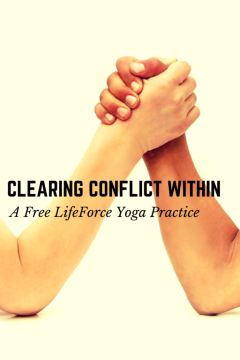
I want to unfold.
Let no place in me hold itself closed,
For where I am closed, I am false.
I want to stay clear in your sight.
Ranier Maria Rilke
When an incident disturbs our peace of mind, we have choices. We’ve all had experiences where we’ve felt unjustly attacked or betrayed. We can turn the conflict over and over in the mind, our thoughts spinning ever tighter, like the bands inside a golf ball. We can attempt to forget it, just toss the betrayal over the fence. Both of these choices close us down. A part of the mind constricts. If we follow the first course of action, obsessing about the incident, we can lose sleep, we can be distracted from our work, and we can distance ourselves from our intimates. Eventually, the knotted ball of pain is internalized in the body, joining in with a chronic tension in the shoulders or neck, or wherever we store stress. We know the effect of stress on body and mind—the increased risk of heart disease is just the most obvious. If we’re anxious and losing sleep over the issue, the insomnia can lead to depressed mood, and we can feel trapped in a seemingly unending cycle of anxiety and depression.
If on the other hand, we attempt to toss it over the fence, “Just let it go,” as a well-meaning friend might say, we may find ourselves raiding the carb cabinet in order not to feel. Or we might indulge in other forms of mindless, patterned behavior (watching too much television, surfing the internet, drugs, sex, alcohol) to numb the pain. Whether we worry and obsess, or try to bury it under the rug, we are closing off parts of ourselves. When we are feeling stressed or scared or misunderstood, it’s easy for those closed off, defended parts to take the lead. We might appear rigid or protected or defensive or falsely congenial. Those closed-down parts within us are there for good reason. They’ve been wounded and they want to protect us from further hurt. Sometimes they do their job so well, that we feel nothing at all. Rilke’s quote speaks for our wise and compassionate inner knowing that wants those young, wounded, shut-down parts to know that it’s safe to release. But how do we clear? How do we stay open through the pain of injustice and betrayal?
One way to do that is to cultivate a practice that helps us clear the space within, which means developing a time to sit daily, watching without judgment what is arising. This doesn’t mean that we deny the object of our dark ruminative thoughts, but rather we have the clarity to observe the incident and notice where it lodges in the body-mind without reacting. But at times it feels impossible to sit through the discomfort of our thoughts and not spiral into a darker place. We might rise from the cushion, feeling just the opposite of Rilke’s expressed yearning. Instead, of the unfolded, open, clarity we seek, we feel as though the fog has rolled in.
I know of no better practice to shine a light through the fog, opening and unfolding us to the clear space beneath the current pain than a practice that engages breath and the energy centers known as the chakras. It’s a short practice that can shift the mood, reminding us that though the feelings and thoughts may remain, we are so much more than our ruminations. It can create a spacious awareness of grounded presence where mindfulness naturally arises—a beautiful portal into meditation.
The practice:
- Sit comfortably with the spine erect or lie down. Begin to notice the breath—first at your nostrils, as it flows in and out, and then notice how the belly is receiving the breath. Notice if the chest is responding to the breath.
- Now imagine that you are inhaling through the crown of your head. Imagine that you are exhaling through your feet. As you inhale through your crown, say to yourself, “I am.” As you exhale through your feet, say to yourself, “here.” Repeat several times, varying it by exhaling through the seat with the word, “grounded.”
- Inhale through the crown, with the words, “I am.” Exhale through the brow point with the word, “clarity.” Repeat several times.
- Inhale through the crown, with the words, “I am.” Exhale through the heart with the word, “compassion.” Repeat several times.
- Now visualize what you imagine to be the source of the conflict you are facing. Inhale through the crown, with the words, “I am.” Exhale through the solar plexus with the word, “courage.” Repeat several times.
- Now visualize an image for calm strength. This can be a scene from nature, an animal, or a powerful image of yourself . As you hold this image in your heart’s mind, inhale through the crown, with the words, “I am.” Exhale through the solar plexus with the words “calm strength.” Repeat several times.
- In the final rounds of this breathing meditation, Inhale through the crown, with the words, “I am.” Exhale through the heart with the word, “love.”
- Now you can remain in meditation, or if there’s a desire to take a harmonizing action that is related to the conflict, you might explore that in writing and then follow through with your action.
 For more than 50 yoga-based practices to help and those you serve with mood-management, read Yoga Skills for Therapists (W.W. Norton)
For more than 50 yoga-based practices to help and those you serve with mood-management, read Yoga Skills for Therapists (W.W. Norton)